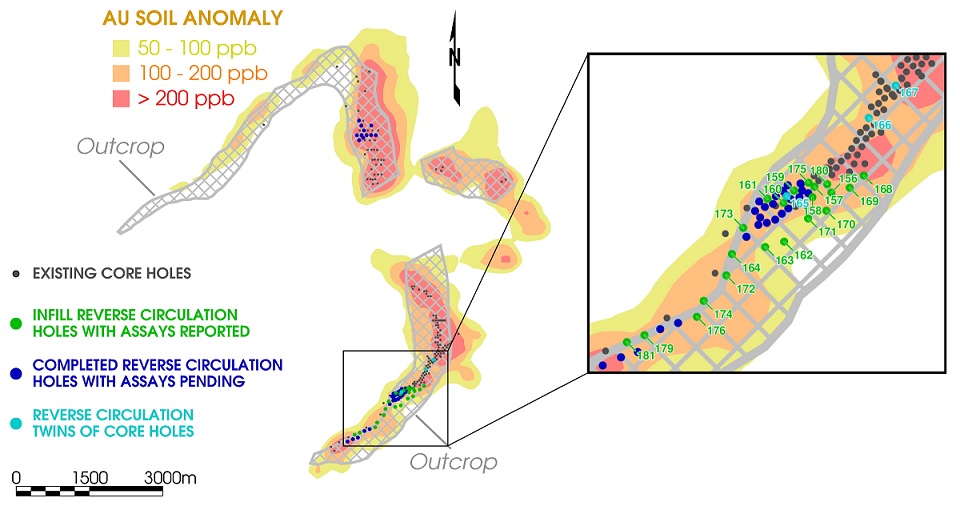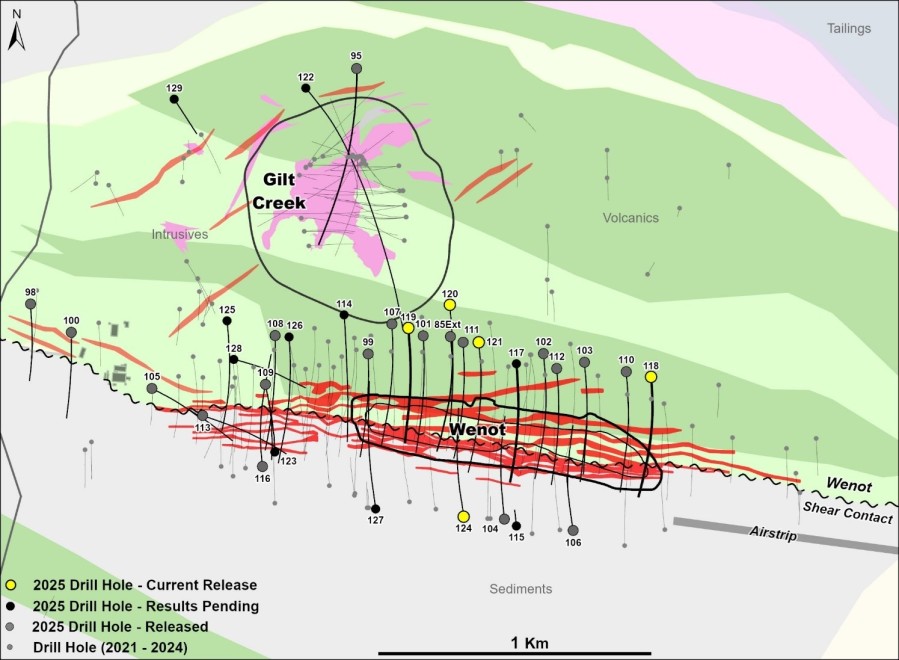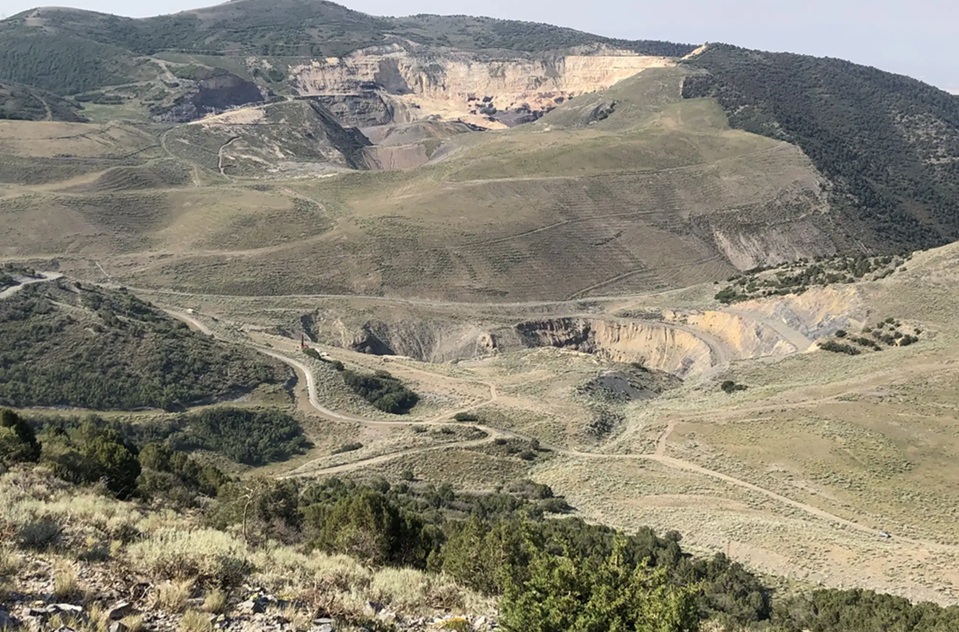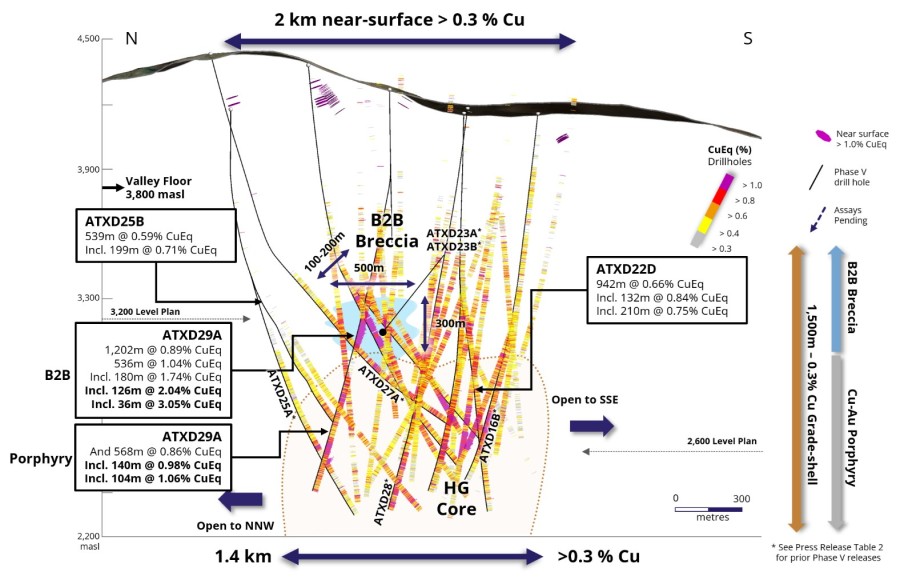SCOTTSDALE, AZ--(Marketwired - July 12, 2017) - The first assay results are now available from the reverse circulation (RC) drilling program at the Castelo de Sonhos (CDS) gold project of TriStar Gold Inc. (TSX VENTURE: TSG) (the "Company" or "TriStar"). This RC drilling program began in May when the first RC rig arrived at site and is now being handled by three rigs, the last of which arrived at site in June. To date a total of 60 holes have been completed for 7,013 m; assay results are now available from 24 holes for 2,747 m. Drilling is expected to continue until we have approximately 15,000 m complete, at which point an updated resource estimate will be calculated and used as the basis for the project's first preliminary economic assessment (PEA).
"We're excited to see CDS moving forward," says Nick Appleyard, TriStar's President and CEO, "the three twin holes have demonstrated to us the benefits of combining low-cost RC drilling with high-value optical televiewer imaging and petrophysical logging to replace expensive core drilling. The first assay results from the in-fill RC holes are consistent with what we saw in the large step-out holes last fall; so, we're looking forward to publishing a PEA later this year that demonstrates our continued belief that this project meets our corporate objectives."
Figure 1 shows the location of the 60 new RC holes that have been completed in the Esperança South and Center regions of the project. All RC holes are vertical, and drilled to a target depth of 120m. A few holes were terminated short of their 120m target due to local conditions; any hole that reaches less than half of its target length is deemed to be abandoned prematurely, and will be redrilled. Three of the new RC holes are closely-spaced twins of previous core drill holes, drilled to provide data on the reliability of analytical data from RC chips.
Figure 1. Location of new RC drilling at Castelo de Sonhos.
In Figure 1, the holes for which more than half of the assay results have now been received are shown in green; the significant intervals in these holes (using a 0.4 g/t cutoff) are shown in Table 1. True width is approximately 85% of the downhole intercept length.
| Table 1. Significant intervals for new RC holes. | ||||||||
| Hole | From | To | Au | |||||
| RC-17-156 | 34 | 35 | 1m @ 1.3 g/t | |||||
| 73 | 74 | 1m @ 0.6 g/t | ||||||
| RC-17-157 | 92 | 93 | 1m @ 0.5 g/t | |||||
| RC-17-158 | 17 | 18 | 1m @ 0.5 g/t | |||||
| 61 | 63 | 2m @ 1.1 g/t | ||||||
| 83 | 84 | 1m @ 0.4 g/t | ||||||
| RC-17-159 | 43 | 48 | 5m @ 2.8 g/t | |||||
| inc. | 47 | 48 | 1m @ 11.3 g/t | |||||
| RC-17-160 | 51 | 60 | 9m @ 2.7 g/t | |||||
| inc. | 59 | 60 | 1m @ 19.6 g/t | |||||
| RC-17-161 | 96 | 99 | 3m @ 3.4 g/t | |||||
| inc. | 98 | 99 | 1m @ 7.8 g/t | |||||
| RC-17-162 | 11 | 12 | 1m @ 0.5 g/t | |||||
| RC-17-163 | No significant intervals | |||||||
| RC-17-164 | 14 | 16 | 2m @ 1.1 g/t | |||||
| 67 | 69 | 2m @ 1.0 g/t | ||||||
| RC-17-165 | 47 | 60 | 13m @ 2.9 g/t | |||||
| (CSH-12-44 twin) | inc. | 53 | 59 | 6m @ 5.4 g/t | ||||
| RC-17-166 | 68 | 85 | 17m @ 2.0 g/t | |||||
| (CSH-12-40 twin) | inc. | 73 | 74 | 1m @ 5.0 g/t | ||||
| inc. | 78 | 79 | 1m @ 6.5 g/t | |||||
| inc. | 82 | 83 | 1m @ 9.7 g/t | |||||
| 93 | 95 | 2m @ 0.6 g/t | ||||||
| RC-17-167 | 58 | 85 | 27m @ 2.5 g/t | |||||
| (CSH-14-104 twin) | inc. | 61 | 63 | 2m @ 6.0 g/t | ||||
| inc. | 70 | 71 | 1m @ 11.1 g/t | |||||
| inc. | 84 | 85 | 1m @ 6.9 g/t | |||||
| RC-17-168 | No significant intervals | |||||||
| RC-17-169 | 5 | 6 | 1m @ 0.6 g/t | |||||
| 8 | 9 | 1m @ 0.6 g/t | ||||||
| RC-17-170 | No significant intervals | |||||||
| RC-17-171 | 94 | 95 | 1m @ 2.0 g/t | |||||
| 114 | 115 | 1m @ 0.6 g/t | ||||||
| RC-17-172 | 20 | 22 | 2m @ 0.5 g/t | |||||
| RC-17-173 | 71 | 77 | 6m @ 4.0 g/t | |||||
| inc. | 75 | 77 | 2m @ 8.6 g/t | |||||
| RC-17-174 | No significant intervals | |||||||
| RC-17-175 | 38 | 39 | 1m @ 1.1 g/t | |||||
| RC-17-176 | 102 | 103 | 1m @ 1.3 g/t | |||||
| RC-17-177 | < 50% of assays received to date | |||||||
| RC-17-178 | < 50% of assays received to date | |||||||
| RC-17-179 | 59 | 60 | 1m @ 0.4 g/t | |||||
| 78 | 79 | 1m @ 0.7 g/t | ||||||
| RC-17-180 | 110 | 111 | 1m @ 0.6 g/t | |||||
| 115 | 116 | 1m @ 0.5 g/t | ||||||
| 118 | 120 | 2m @ 0.5 g/t | ||||||
| RC-17-181 | 48 | 49 | 1m @ 0.6 g/t | |||||
| 72 | 73 | 1m @ 24.2 g/t | ||||||
As shown in Figure 1, the RC drilling in-fills gaps in previous core drilling. When compared to the surrounding core drill holes, the significant intervals of the new RC holes reported in Table 1 are, on average:
- lower in thickness by 17%
- higher in grade by 25%
- resulting in higher grade x thickness by 4%
These results are consistent with the fact that sample interval length is 1m for the new RC drill holes, and was 2m for the previous core drill holes.
Sample analysis procedures and QA/QC protocols
As it has done with each new phase of drilling, TriStar has reviewed the data from its quality assurance and quality control (QA/QC) program. With abundant free gold, some of which is coarse (>100 microns), the project benefits from the larger volume samples available with RC drilling. In order to ensure that as much material as possible is being analyzed by the lab, TriStar has switched to 1m sample intervals and has begun using the Leachwell procedure, an analytical procedure that uses an aggressive acid leach to extract gold from a 1 kg sample. The first Leachwell analyses indicate that they have higher precision than fire assays; this is likely due to the mass of the analyzed material being approximately 20x larger in a Leachwell assay than the 50g aliquots analyzed in a conventional fire assay procedure. The results presented in Table 1 include a combination of fire assays, done in duplicate or triplicate, and Leachwell assays.
Sample preparation and analytical work for the Castelo de Sonhos drilling program were carried out by SGS Geosol and ALS laboratories. SGS Geosol did sample preparation at its lab in Parauapebas, Pará State, and fire assays at its lab in Belo Horizonte, Minas Gerais; ALS did sample preparation at its lab in Goiania, Goias and Leachwell assays at its lab in Lima, Peru. All of the laboratory facilities, both the prep labs and the analytical labs, are ISO 9001:2008 and 14001:2004 certified. Both SGS Geosol and ALS use industry-standard analytical methods and have internal QA/QC programs to monitor the reliability of their work. Independently of the labs, TriStar runs its own external QA/QC program, using standards, blanks and duplicates inserted into the sample processing stream at a rate of one per 10 samples.
TriStar's Vice-President, R. Mohan Srivastava (P.Geo.), is the QP for this press release and has prepared or supervised the preparation of the scientific or technical information in this press release.
About TriStar:
TriStar Gold is an exploration and development company focused on precious metals properties in the Americas that have potential to become significant producing mines. The Company's current flagship property is Castelo de Sonhos in Pará State, Brazil. The Company's shares are listed on the TSX Venture Exchange under the symbol TSG. Further information is available at www.tristargold.com.





